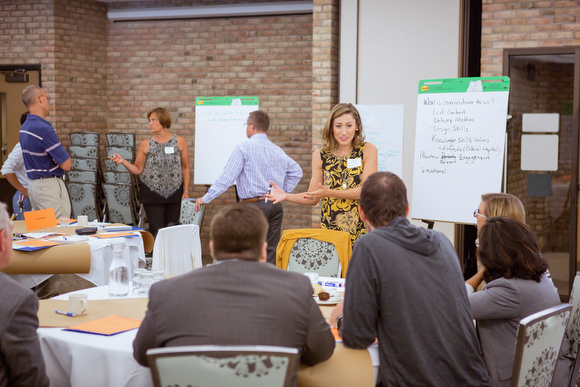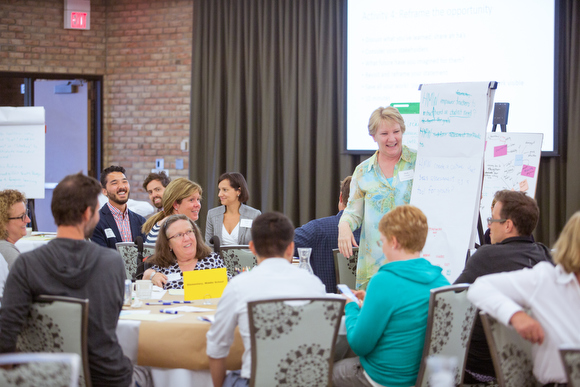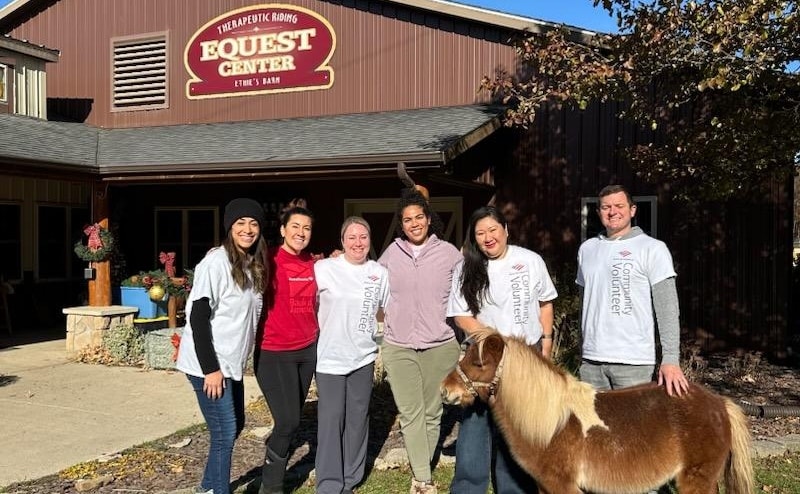At GVSU, an emphasis on design thinking is leading to big changes in education
A recent design thinking conference at Grand Valley State University tackled big questions, including: what makes the world run better, especially when it comes to our schools?

When a group of students, educators and business leaders recently gathered at the K-12 Design Thinking Summit at Grand Valley State University, they were doing so to tackle such questions as: How do you make graduates more employable? How do you adapt to the ever-changing workforce? What needs to happen to encourage creativity among students, as well as administrators — and to teach them to not be afraid to fail? Essentially, what makes the world run better, especially when it comes to our schools?
While all of these questions, of course, involve complex, layered solutions, there’s one phrase that envelops them all: design thinking. In other words, using an innovative, human-centered approach to problem solving. Design thinking, which has been, among others, pioneered by David Kelley (who Rapid Growth profiled in a previous article), the founder of the Hasso Plattner Institute of Design at Stanford University and the Silicon Valley design firm IDEO, harnesses creativity and empathy to solve problems, large and small, among a group of people. This process has been used by, for example, Kelley and IDEO to do everything from fix a floundering school system to create a global plan for disaster response and even redesign death.
Such a concept has brought new thinking and problem solving to the globe on a wide scale, changing the way we eat, play, work, travel, and, yes, die — and it is playing a key role in Grand Rapids, from the classroom to the board room, explains John Berry, the director of GVSU’s Design Thinking Initiative.

Berry helped to found the Design Thinking Initiative in 2014 and has more than four decades of innovative design-related involvement with corporations, higher education, and nonprofit groups, both on a regional and national level. The founder and executive director of Design West Michigan, Berry also served as vice president for corporate communications for Herman Miller.
“Design thinking is a process; it’s not a formula,” Berry says. “It’s messy, it starts very ambiguously, and it revolves around solving an issue.
“Design thinking is a process designed at meeting the needs of others; it’s a team of people collaborating to understand the needs of others,” he continues.
So, how does that translate to the K-12 Design Thinking Summit that was held at GVSU on Aug. 15? Essentially, it got everyone from educators and students to business leaders talking about what education could be — and how we can get there. This means everything from larger, conceptual ideas, like teaching students to embrace failure, to the more concrete, like getting a group of fourth graders to work on ending homelessness.

These summits have grown increasingly popular, growing from 12 school districts being involved in the first summit to 14 in the second and now 18 in the third. Plus, 10 different companies sent representatives to the day-long event, and there were people from throughout the area’s K-12 community, as well as design thinking students from GVSU. During the summit, participants got to hear design thinking success stories from various academic institutions, as well as participate in the design thinking process themselves. Plus, students and educators got to connect with businesses regarding what kind of skills employers want their employees to have.
“There was so much energy and excitement” during the summit, Berry explains, noting that design thinking is becoming an increasingly used concept throughout West Michigan’s schools.
“The Ottawa area [Intermediate School District] has been providing the most experience with design thinking in West Michigan, and Kent is getting into it,” Berry says. “Of the 18 school systems at the summit, some are totally engaged in design thinking and others are wanting to be engaged.”
“Design thinking unlocks creativity in individuals,” Berry explains. “You see kids get excited that they can actually get into an issue and work on solving it.”
At GVSU, design thinking continues to expand, including with a “Design Thinking to Meet Real World Needs” course, which launched last fall, as well as a design thinking club, which GVSU senior Andrew Hereza, a political science and nonprofit and administration major, is co-founding with Nikhil Watsa, a junior majoring in physics. The club, named the Design Thinking Collaborative, aims to connect students with the design thinking process outside of the classroom.
“With the student club, we’re hoping to attract a large number of students, bring them in and give them a myriad of opportunities in design thinking,” says Hereza, who too attended last month’s K-12 summit.
For Hereza, design thinking, which he notes he “immediately fell in love with” when he was first introduced to it about a year ago, plays a crucial role in making students more employable once they graduate from school.

“Empathy, diversity and team building — all of these things, which are important in design thinking, these skills make you more employable,” Hereza says. “A lot of corporations in West Michigan are looking for students with these skills. They may not call it design thinking; they may just call it empathy and team building or being an innovator, but knowing these skills makes you more marketable in the business world.”
Numerous students, including Hereza, stressed the importance of design thinking in schools and say they’re thrilled to see an increasing number of educators and administrators in West Michigan incorporate the concept into their schools and classrooms.
“It brings a fundamental transformation in education,” Hereza says. “Collaboration, working with teams, working to find a solution to a problem in a way that engages people, these are things that aren’t really taught in formal schooling, but they are so important once you get into the real world.”
Andy Van Solkema, the founder of the human-centered design firm Visualhero and now the chief designer at OST, attended the K-12 summit for the first time last month, and he, like many of the business representatives at the event, stresses the integral role design thinking plays in his organization, even if he’s not always keen on the term.
“Like many designers, I have this love-hate relationship with the term ‘design thinking,’ laughs Van Solkema, who’s a graduate of GVSU’s design school. “It’s a very important term because it gives the rest of the world context to what design thinking is. To me, it’s creative problem solving. As a designer and someone who grew up being creative and has gone on to become a graphic designer after college, that curiosity and creative solving aspect was perpetuated through design and artwork. I always had curiosity and a need to apply that curiosity to the world.”
Long a devotee of design thinking, and a fan of Kelley’s IDEO firm (which inspired him to start Visualhero), Van Solkema says design thinking, and collaborative problem solving, inspired Visualhero to hire a diverse array of people, from graphic designers and copywriters to people with MBAs and individuals with psychology backgrounds, among many others.
“We’ve seen people with more of a diverse background coming to the table,” Van Solkema says. “[Design thinking] is giving permission to creative thinking that business before” had not readily emphasized or embraced.
In addition to getting to speak to students and educators about the ease with which design thinking skills help students translate their academic lives to careers in business, Van Solkema too says the concept can be a game changer in education.
“We measure reading and writing; why don’t we measure empathy and curiosity?” he asks.
“The ability for our culture and our businesses and schools to build a higher level of empathy for curiosity and creativity across the board is something we’re going to have to work on forever,” Van Solkema continues. “As we change our businesses and our education system, so will our culture and technology and the needs of people and businesses.”
This integration of design thinking into education is “very empowering,” says GVSU junior Chris Lopez, another summit attendee.
“If you can tell students it’s OK to fail; it’s a great thing to fail, but it’s important to not give up, that changes everything,” Lopez says. “In reality, it’s great to think about the lone scientist who comes up with a great idea, but the reality is it’s a true collaborative effort. Design thinking says no one person can do this by themselves.”
“I have friends who are afraid of failure,” Lopez continues. “They won’t answer questions unless they know they’re going to get it right. I fail 20 to 30 times a day, and I’m happy with that because it brings me closer to success.”
Photos by Kristina Bird/GVSU








